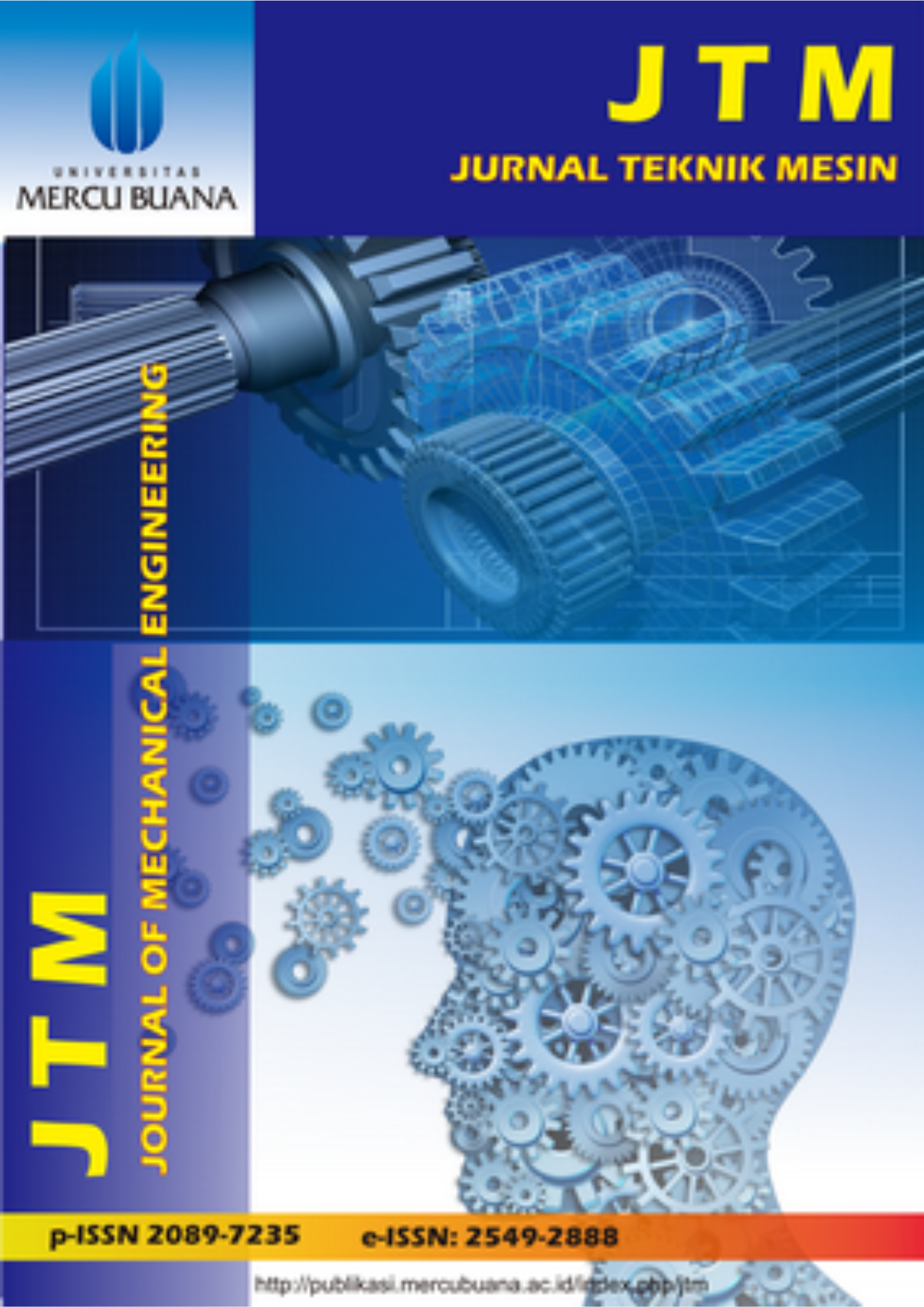EFFECT ANALYSIS OF ROTATIONAL SPEED CHANGES ON PROPELLER TURBINES ON THE POTENTIAL FOR CAVITATION FORMATION USING COMPUTATIONAL FLUID DYNAMIC METHOD (CFD)
Abstract
Water is an inexhaustible resource. In Indonesia there are several areas that have the potential of water energy for electricity production. Water energy can be used for electricity production and supports emission reduction programs because it does not produce CO2 emissions during the electricity production process by water turbines. One of the problems experienced by turbines is damage caused by cavitation. Cavitation itself is the formation of air gas bubbles due to very low pressure reaching below the vapor pressure, so that water evaporates at low pressure. This research was conducted to determine the effect of rotational speed on the potential for cavitation. This research was conducted using the CFD method and using the ANSYS application. In the simulation process, several variables are used, namely rotational speed and fluid velocity. The conclusion of this study is that the higher the rotating speed of a propeller turbine, the higher the cavitation potential that will occur in the propeller turbine. Because the higher the rotational speed of a turbine,so the lower the pressure that occurs in the turbine, this is in accordance with Bernoulli's Law. Suggestions for further research can be done with several modifications or variations of the winglet radius so as to get a better design. In addition, in future research it is also possible to modify the angle of the blade so as to reduce the emergence or formation of gas bubbles on the propeller blades due to decreased pressure.
Keywords
Full Text:
PDFReferences
. Hamdani. D.. (2023). Listrik Hijau dari Parit. Diambil dari website: https://pengabdian.lppm.itb.ac.id/terap/listrik_hijau_dari_parit.
. Ferial.. (2015). Energi Air Terangi Jawa Tengah. Diambil dari website: https://ebtke.esdm.go.id/post/2015/03/02/793/energi.air.terangi.jawa.tengah.
. Ramelan. S.. (2018). Analisis Pengaruh Perubahan Sudut Sudu Turbin Hydrocoil Terhadap Potensi Terjadinya Kavitasi Menggunakan Metode CFD (Computational Fluid Dynamic). S1 thesis. Universitas Mercu Buana Jakarta.
. Effendy. M.. Wijianto. (2010). Aplikasi Response Getaran untuk Menganalisis Fenomena Kavitasi Pada Instalasi Pompa Sentrifugal. Jurnal Penelitian Sains & Teknologi. Vol. 11. No. 2. 2010: 191 – 206.
. Celebioglu. K.. Altintas. B.. Aradag. S.. & Tascioglu. Y. (2017). Numerical research of cavitation on Francis turbine runners. International Journal of Hydrogen Energy. 42(28). 17771–17781. https://doi.org/https://doi.org/10.1016/j.ijhydene.2017.03.180
. Himaran. Syukri. (2017). Turbin Air Teori & Dasar Perencanaan. Penerbit Andi. Jogjakarta.
. Gohil. P. P. & Saini. R. P. (2016). Numerical Study of Cavitation in Francis Turbine of a Small Hydro Power Plant. Journal of Applied Fluid Mechanics. 9 (1). 357-365.
. Luthfie. A. A. (2017). Analisis Pengaruh Perubahan Sudut Pipa Siphon Terhadap Performasi Turbin Hydrocoil Dengan Menggunakan Metode Computational Fluid Dynamic (Cfd). Jurnal Teknik Mesin Mercu Buana. 6(1). 41-47.
. Aulia. A.. Nasrul. Z. A.. Sylvia. N.. Hakim. L.. & Bahri. S. (2022). Kajian Terhadap Kavitasi Dan Pressure Drop Pada Bukaan Control Valve Tipe Globe Valve Dengan Menggunakan Software Autodesk CFD (Computational Fluid Dynamics). Chemical Engineering Journal Storage (CEJS). 1(4). 57-66.
. Cengel. Y. A.. &Cimbala. J. M. (2006). Fluid Mechanics: Fundamentals and Application. New York: McGraw-Hill.
. Darmawan. D. B.. Chrismianto. D.. & Iqbal M. (2016). Analisa Kemiringan Sudut Propeller Tipe B-Series Pada Kapal Selam Tipe Menengah Untuk Mengoptimalkan Kinerja Kapal Selam Dengan Meotde CFD. Jurnal Teknik Perkapalan - Vol. 4. No. 2 April 2016. 352-361.
. Febrianto. A.. Santoso. A. (2016). Analisa Perbandingan Torsi dan RPM Turbin Tipe Darrieus Terhadap Efisiensi Turbin. Jurnal Teknik ITS Vol. 5 No. 2. 517-521.
. Lanzafame. R.. Mauro. S.. & Messina. M. (2013). Wind turbine CFD modeling using a correlation-based transitional model. Renewable Energy. 52. 31-39.
Li. Y.. Paik. K. J.. Xing. T.. &Carrica. P. M. (2012). Dynamic overset CFD simulations of wind turbine aerodynamics. Renewable Energy. 37(1).285-298.
. Wang. Y. F.. & Zhan. M. S. (2013). 3-Dimensional CFD simulation and analysis on performance of a micro-wind turbine resembling lotus in shape. Energy and Buildings. 65. 66-74.
. Naveenagrawal. Stonecypher. Lamar. (2009). Cavitation in Hydraulic Turbines: Causes and Effects. Di ambil dari website: http://www.brighthubengineering.com/fluid-mechanics-hydraulics/27427-cavitation-in-hydraulic-turbines-causesand-effects/
DOI: http://dx.doi.org/10.22441/jtm.v13i3.18667
Refbacks
- There are currently no refbacks.
Copyright (c) 2024 Jurnal Teknik Mesin
Jurnal Teknik Mesin (JTM)
Program Studi Teknik Mesin, Fakultas Teknik, Universitas Mercu Buana
Jl. Meruya Selatan No. 01, Kembangan, Jakarta Barat 11650, Indonesia
Email: [email protected]
Telp.: 021-5840815/ 021-5840816 (Hunting)
Fax.: 021-5871335
JTM is indexed by the following abstracting and indexing services:

This work is licensed under a Creative Commons Attribution-NonCommercial 4.0 International License.






.png)







_(486_x_90_px)_(486_x_190_px)_(486_x_190_px)_(4).png)
_(486_x_90_px)_(486_x_190_px)_(486_x_190_px)_(5).png)
2.png)
.png)